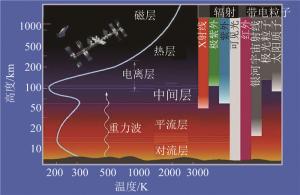HTML
-
随着空间遥感技术以及火箭运载技术的发展,空间光学系统的口径得到很大的提升,空间光学系统的分辨率也随之大大提升。如今,空间相机已在地质、水质勘探、农业遥感观测、地球环境监测、深空探测、军事侦察等领域都发挥了重要作用。
1990年,人类首次成功将大口径空间望远镜——哈勃(Hubble)空间望远镜发射进入太空[1]。直到今天,Hubble太空望远镜仍是已发射上天的最大的一体式主反射镜的太空望远镜。2009年发射的Herschel赫歇尔空间望远镜[2-5]以及一再推迟发射的JWST詹姆斯韦伯空间望远镜[6-9],主反射镜均采用了拼接结构。
20世纪八、九十年代是研究大口径空间相机研究热点时期,但伴随着研制周期长、研究费用高昂的缺点,大口径空间相机的研究热度逐渐降低[10-11]。近年来,随着空间遥感,大口径反射镜制备技术以及火箭运载技术的进步,大口径空间相机重新走入了人们的视野。目前大口径空间相机仍面临更宽的工作谱段、基底光学性能提升、空间环境的影响以及薄膜应力的影响这几方面的困难。作者对近年来空间相机大口径反射镜高反膜的研究成果, 以及科研过程中遇到的问题相对应的一些新的解决思路和方法进行了综述。
-
早期空间相机在可见光谱段的工作范围是450nm~900nm。随着可观测对象的增多,400nm~450nm谱段越来越受到重视,在监测内陆及海洋水质、矿物质识别、森林植被覆盖监测等研究方向都拥有重要的应用[12-15]。表 1中列举了部分该谱段的应用领域及谱段中心波长等技术参数。
领域 观测对象 监测精度 对应谱段中心波长 信噪比/dB 光谱分辨率/nm 空间分辨率/m 幅宽/km 内陆和近海水体水质反演 有色溶解性有机物 > 0.01m 355nm, 375nm, 440nm或者412nm, 442nm 250 5 近海:≤250;大型内陆水:≤30; 100 溶解性有机碳 > 70% 412nm, 442nm或者670nm, 530nm, 412nm 矿物识别 Fe2+ — 1000nm~1100nm, 550nm, 510nm, 430nm, 450nm, 1800nm~1900nm 150 10 15 80 Fe3+ 870nm, 700nm, 520nm, 490nm, 450nm, 400nm Ni2+ 1250nm, 750nm, 400nm Mn2+ 340nm, 370nm, 410nm, 450nm, 550nm Cr3+ 400nm, 550nm, 700nm 植被 叶绿素含量 80% 400nm~800nm 250 5 15 20 目前国外研制的空间光学相机的光谱指标已经由450nm扩展到400nm。表 2中为国外部分光学相机技术参数。
仪器 国家 工作谱段/nm 通道数 光谱分辨率/nm 幅宽/空间分辨率 轨道高度/km 分光方式 用途 COIS(军) 美国 400~2500 210 10 30km/30m 605 光栅 用来对海洋进行观测 Hyperion(在轨) 美国 400~1000
900~2500220 10 7.5km/30m 705 光栅 地球观测 CRISM 美国 400~4050 558 6.55 10km/50m 325(火星) 光栅 火星表明地质勘测和水质分析 ARTEMIS(军) 美国 400~2500 > 1000 5 4m 426~456 光栅 先进快速响应战术有效军用超光谱成像 CHRIS(在轨) 欧空局 400~1000 19~62 5~12 14km/20m 533~688 棱镜 陆地遥感包括植被制图,农业作物预测,林业,水质,空气质量和污染监测和海洋的监测 GSA 俄罗斯 400~1100 96 5~10 2100km/30m 474 资源观测 对高光谱数据进行反演,可获取到地物反射光谱特性。利用反射光谱特性可进行地球表面物质的成分、形态、分布、含量、动态变化以及物体分类方面的研究。为了提高近紫外到近红外谱段光学系统的观测成像质量,完成近紫外到近红外谱段范围光学仪器共用光学视窗的研究,在一定程度上减轻观测设备的自身重量,使其更为轻巧精密,将工作谱段进一步扩展到了350nm。表 3中为几种典型成像光谱仪的相关参数。
传感器 生产国 光谱范围/nm 波段数 主要用途 HYMAP 澳大利亚 350~2500 252 陆地资源观测 AVIRIS 美国 380~2450 224 生态、海洋、地质、水 PHI-1 中国 400~800 244 陆地生态系统、资源调查 Hyperion 美国 400~2500 220 陆地生态成图、精确分类 MODIS 美国 415~14240 36 全球观测、大气 CASI 加拿大 430~870 288 生态系统、陆地表面观测 ALI 美国 433~2350 20~300 陆地资源观测 AISA 芬兰 450~900 286 水文、地质、农林业 FTHSI 美国 475~1050 150 用途广泛 ASTER 美国 760~12000 20 云、陆地表面测量 AIS 美国 800~2400 128 矿物识别、植物受害识别 空间相机反射镜高反膜材料一般为金属材料,增加反射镜的工作谱段往往需要在金属膜上镀制具有一定膜层结构的介质膜,这就造成增加空间相机工作谱段范围的同时引起反射率的降低[16]。另外以前由于材料和科学技术的限制,在金属膜上镀制满足空间工作环境的介质膜是十分困难的。随着科学技术的发展,目前在反射膜的制备上将大口径空间相机的工作谱段拓宽已经可以实现。
由于增加空间相机工作谱段范围的同时会引起反射率的降低,因此,目前宽谱段大口径空间相机反射镜研究工作的重点在于保证空间相机在足够宽的工作谱段范围内都具有足够高的反射率。现阶段较常采用的方法是在金属膜上镀制一定膜系结构的介质膜来提升近可见波段的反射率,介质膜较常采用的材料有SiO2, Ta2O5, HfO2等。
目前国内高分五号卫星在400nm~2500nm全谱段平均反射率大于95%。国外在250nm~700nm的工作谱段范围平均反射率已达到97%以上。北京空间机电研究所WANG研究团队目前已将空间相机大口径反射镜400nm~450nm工作谱段的反射率提升至95%以上,400nm~900nm宽工作谱段平均反射率不低于98%;350nm~1200nm谱段平均反射率提升至97%以上,350nm~500nm工作谱段反射率不低于90%。
-
20世纪上半叶,空间相机的主镜普遍采用如微晶玻璃、熔石英等膨胀系数比较低的的这一类材料。这类材料能够很好地满足空间光学系统的抛光要求,能够制造成满足需要的空间光学反射镜基底。但是,这类材料的强度不佳,不满足抗热形变方面要求,难以进行轻量化设计,因此不适用于制备大口径空间相机主镜基底。20世纪70年代,碳化硅(SiC)和碳化硅基复合材料开始应用在空间反射镜领域。碳化硅和碳化硅基复合材料具有耐销蚀、耐高温、强度大、抗冲击、导热性能良好等优点,可以充分满足空间相机大口径反射镜对于基底材料选择的要求[17-20]。
但是碳化硅基底的加工效率低,表面较为粗糙,若直接在其上镀制反射膜会使表面光散射损耗较大,无法满足空间应用的需求,因此,在镀制反射膜之前需要对碳化硅基底进行改性。
目前常采用的改性方法是在SiC基底上镀制10μm左右的Si,再对反射镜表面进行抛光加工,改性后基底表面粗糙度可达到2nm左右。但是这种方法有两个缺点:一是对镀有10μm Si膜磨制时有磨漏的风险; 二是Si膜层应力过大[21]。
最近一种新的SiC基底改性方法已被提出[22],这种方法是在研磨后的SiC表面直接镀制10nm厚度的Ti成核层,通过这种方法可以避免磨漏的风险,同时可在一定程度上对SiC表面粗糙度进行改善。
-
近地空间[23]一般指从海平面起100km~36000km的球壳状空间区域。对航天任务影响较大的空间环境因素主要有:真空热循环、空间带电粒子辐射、原子氧、电离层、地磁场以及空间碎片等。图 1为常见的空间环境。
由于反射镜口径增大所带来的影响远小于材料本身所受空间环境的影响,因此, 目前空间环境对空间反射镜高反膜影响研究的热点主要集中在膜层本身所受真空热循环、空间带电粒子辐照和原子氧影响这几方面。
-
在真空热循环的影响下,光学元器件主要的损伤表现形式有以下两种[24]:(1)光学膜层剥落。由于膜层与基底之间的热胀系数存在差异,当经过热循环过程后,膜层与基底之间由于热应力的影响,会导致膜层的脱落; (2)反射镜面形的改变。大口径反射镜对面形的要求很高,在热循环作用的影响下,大口径反射镜表面的温度相对于内部的变化更为剧烈,产生边缘效应,在反射膜材料内产生较大的应力,导致反射镜的面形发生改变。参考文献[25]中对直径200mm的反射镜进行了高低温试验,基底材料选择石英玻璃,实验结果如表 4所示。表中, λ是波长。
实验内容 实验前时的面形均方根差 实验后时的面形均方根差 均方根差的变化量 低温试验 0.085λ 0.087λ +0.002λ 高温试验 0.089λ 0.085λ -0.004λ 为了减小真空热循环对反射膜的影响,目前较常采用的做法是根据航天器运行轨道计算每天热循环次数,再根据航天器的使用寿命计算出寿命周期内热循环总数,结合有限元分析软件以及试验检测来对反射膜的性能进行优化。
-
QI等人[26-27]对石英基底反射镜和微晶玻璃基底反射镜进行高能质子、电子辐照试验。研究结果表明:MeV以上的高能质子和电子辐照对反射镜光学性能影响有限。
参考文献[28]中研究了低能质子、电子辐照对铝膜光学性能的影响。发现质子辐照会导致反射镜在200nm ~ 800nm的波段内反射率出现下降;随着辐照强度的增加,反射镜的反射率下降更为明显,且出现红移现象;质子辐照对于对于红外光谱范围,影响十分有限;随着辐照强度的增加,损伤具有降低的趋势。
100keV不同强度电子辐照试验表明,辐照后反射镜反射率在200nm~ 210nm谱段稍有下降,其余谱段反射率未出现明显变化。一定强度的质子辐照能会使反射镜表面起泡。
由于辐照度的影响是一个长期过程[29-30],目前降低空间粒子辐照对反射膜光学性能的影响的方法还是使用运用SRIM程序计算不同能量的质子在反射镜表面膜系中进入深度以及能量损失,参照仿真结果来分析质子能量对反射镜辐照效应的影响,并用质子辐照试验对分析结果进行验证,以此来调节镀膜参数,达到降低粒子辐照对反射镜光学性能的影响的目的。
-
原子氧具有极强的氧化性,很容易和作为大口径反射镜镀膜材料的铝和银反应生成的氧化物,造成反射膜层逐渐剥蚀。同时原子氧还可与铝、硅等材料形成粘性氧化物,影响光学系统性能[31]。
参考文献[32]中研究了原子氧对聚酰亚胺/Al薄膜性能的影响。结果表明:原子氧的辐照时间与薄膜材料的质量损失成正比;进行原子氧辐照时,聚酰亚胺/Al膜的吸收率呈上升趋势,随着辐照时间的延长吸收率增幅趋于平稳;随着原子氧作用时间的延长,薄膜材料表面粗糙度也随之增加。实验开始后1h~2h时,薄膜材料表面粗糙度变化不大;在2h~12h实验时间内,薄膜材料表面粗糙度变化明显,材料的吸收率变化较大。
目前减小原子氧[33-34]对反射膜影响的方法是在金属膜上镀制厚度足够的保护层,并且在镀制保护层时应保证保护膜层得到充足的氧化。
3.1. 真空热循环的影响
3.2. 空间带电粒子辐照的影响
3.3. 原子氧的影响
-
目前在大口径基底上镀制反射膜通常采用热蒸法或者溅射法。当镀膜材料在基板上沉积时,这一过程是镀膜材料从熔融状态气体沉积转变为固体薄膜的相的变化,另外, 在沉积过程中,由于沉积粒子间的拉伸、挤压,会造成成膜过程产生微孔、缺陷等,进而在镀膜过程中产生内应力;由于薄膜和基板之间的热膨胀系数不同,镀膜完成后在却过程中会导致热应力的产生[35]。
对于薄膜光学系统来说,其稳定性与应力大小成反比关系。
金属反射膜的应力主要来源于从镀膜温度冷却至室温产生的热应力[36],因此, 在降低金属反射膜应力方面的研究主要集中于此,通常采用的方法是在镀膜前对膜层在冷却过程中的热应力进行有限元分析[37-42],利用有限元分析的结果作为参考对镀膜参量进行调整。
反射膜的应力受到镀膜工艺参量的影响,通过对镀膜温度、氧分压等工艺参量的调整可以有效降低薄膜应力;另外可以通过对膜系组合优化、增加连接层等方式降低多层膜的整体应力值;还可以根据膜层材料的不同选择合适的退火温度,同样可以达到减小应力的目的。
-
随着我国近些年的快速发展,对于大口径空间相机的科研、军事需求也越来越强烈。2016年,我国启动了长征九号重型运载火箭项目研发,预计2028年前后具备能力投入使用,其运输能力可满足Ø4m~Ø7m范围内的一体式天基光学载荷。得益于此,我国也提出了更大的口径、更宽的工作波段、更稳定的光学性能等一些参数要求。在国家的支持下,与之相关的反射镜基底研磨技术、大口径反射膜镀制技术也有了长足进步。但在基底应力控制技术上,如何降低空间环境对反射膜光学性能的影响, 以及降低反射镜设计制备成本等方面仍有很多问题需要解决。相信通过研究人员坚持不懈的努力,可争取早日将我国自己的大口径空间相机发射上天。

 Map
Map





 DownLoad:
DownLoad: